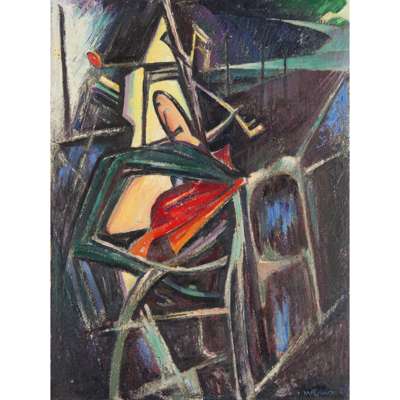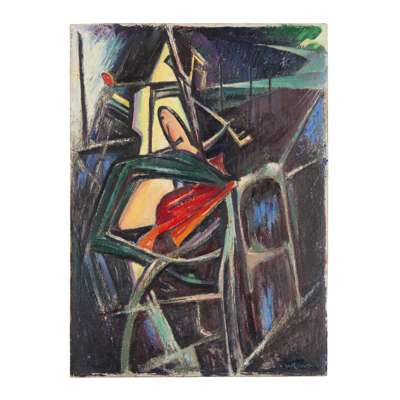
Lot 26

WILLIAM MCCANCE (SCOTTISH 1894-1970) §
FORCE X, OR DIKS RAC (THE ACCIDENTAL APPROACH) - 1961








Auction: 25 June 2025 from 10:00 BST
Description
Signed and dated ’61 lower right, inscribed verso, oil on board
Dimensions
61cm x 45cm (24in x17.5in), unframed
Provenance
From the Estate of William McCance.
Literature: Patrick Elliott, Wiliam McCance, 1894-1970, National Galleries of Scotland, Edinburgh, 1990, p.17, pl.12.
Footnote
Diks Rac is ‘car chase’ written backwards.
Inscriptions verso read:
Car Skid or one up for the road
Diks Rac, The Accidental Approach
Re-titled: Force X,
after May Abbott talk
Woman's Hour
Oct 20 1964
W McCance
28 Avenue
Girvan.
The Art Edit presents paintings, drawings and prints by William McCance (1894–1970) and his circle. McCance and his wife Agnes Miller Parker (1895-1980) moved to London in 1920 and were amongst the earliest Scots to adopt a Wyndham Lewis-inspired vorticism. Their mutual inclination towards line and pattern lent itself well to the graphic arts. Miller Parker was a talented wood engraver and illustrator, while McCance worked across painting, printmaking, design, sculpture, writing and typography.
In 1930 McCance became second Controller of the Gregynog Press, a significant private press in Montgomeryshire, Wales. The Press flourished under his stewardship, and he oversaw the production of several exquisite limited edition publications.
Gregynog was unique at the time in that publications were printed, typset, illustrated and bound under one roof. McCance and Miller Parker contributed designs and engravings, as did the artists Gertrude Hermes (1901–1983) and Blair Hughes Stanton (1902-1981), who was also employed at the Press in a directorial capacity. However, owing to fraught relations with the owners of the Press, McCance resigned after three years.
In 1933, having relocated to a converted windmill in Albrighton near Wolverhampton, he began to work on figurative red clay compositions which he fired at a local brickworks. Their curvature and solidity exhibit an affinity with the contemporary output of Henry Moore and Frank Dobson. These sculptures feature repeatedly throughout McCance’s still life paintings of the 1940s, and while McCance’s style had by this point changed substantially, his use of sculptural studio props endured.
By 1943 McCance was lecturer in Typography and Book Production at the University of Reading. The few works from this later period held in public collection indicate a preoccupation with the Venus of Laussel, the c.25,000 year old limestone figure of a female nude discovered in 1911 in a rock shelter in the Dordogne. McCance likely encountered the Venus during a visit to the region after the Second World War, and nude figures with smooth simplified curves inspired by the Venus recurred within his work hereon.
McCance parted ways with Miller Parker in 1955, and by 1960 he had retired to Scotland. He died in Ayrshire in 1970.








